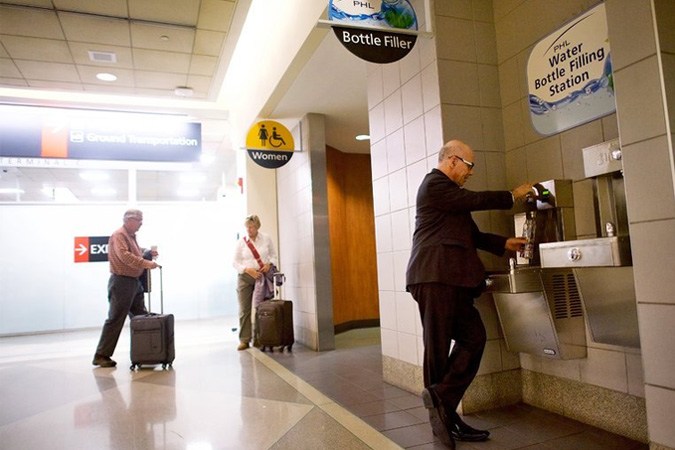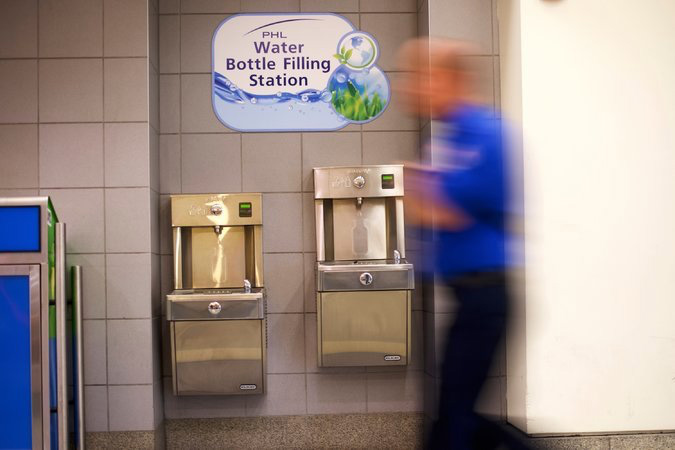
Dr. Stephen Klasko, chief executive of Thomas Jefferson University and Jefferson Health, who typically travels two or three times a week, refilling his water bottle at a station in Philadelphia International Airport. Mark Makela for The New York Times.
November 20, 2017
By JOSHUA BROCKMAN
Remember the days when you could just bring a bottle of water from home to the plane? The days before airport security, which allows you to carry liquids only in containers of 3.4 ounces or less?
Until recently, your only options were a fountain, probably with low water pressure, or a $5 bottle of water from the cafe near your gate.
But now, a growing number of airports have begun to install bottle-filling stations for thirsty travelers near bathrooms and water fountains. The easy-to-use stations are part of an effort to find more sustainable ways to manage crowds (and the empty bottles they leave behind) and to improve airport amenities. Best of all, the water is free.
The installations are already at smaller airports from Portland, Me., to Portland, Ore., and at major hubs, including Atlanta, Chicago, Denver, Philadelphia and San Francisco. The water is filtered in some locations.
Both Elkay and a competitor, Oasis, manufacture hands-free bottle-filling stations that are ergonomically fashioned to fit water bottles. Travelers can place a water bottle under a spout with an automatic sensor — an electric eye — that stops the flow of water when the bottle is full. This eliminates the need for any levers or buttons where germs or bacteria can be transmitted. Some airports purchase stations with a push button instead. One of the most common stations has a combination of a water fountain or bubbler below with a bottle-filling station above.
Dr. Stephen Klasko, the chief executive officer of Thomas Jefferson University and Jefferson Health in Philadelphia, who flies close to 150,000 miles a year, says he now carries an empty water bottle in his briefcase and fills it up near the gate.
As a marathon runner and an obstetrician, Dr. Klasko says he follows a disciplined hydration regimen when he flies. “I make sure that at least every other drink that I have is water,” he said. If he wants a second cup of coffee, he imbibes eight ounces of water first. Alcohol? Not a chance.
“Plane cabins are pressurized to simulate about 8,000 feet, which makes it more difficult to absorb oxygen,” he said. “Sitting affects blood circulation, which also decreases oxygen flow. The recirculated air in planes is extremely dry. You exhale moist air and breathe in dry air.”
He said he was already using a reminder on his Apple Watch to stand up during long flights, so he also set an alarm to prod him to have a drink every hour or so.
The Philadelphia airport has large “bottle filler” signs that call attention to 21 Elkay stations in the secure area of seven terminals. Leah Douglas, the airport’s director of image, said the airport plans to add stations at all baggage claim areas before the end of the year.
Elkay introduced its bottle-filling stations to airports in 2010 with a “quick, clean and green” strategy, said Ted Hamilton, executive vice president. The stations can fill bottles at a rate of up to 1.5 gallons per minute, with water that flows from a recessed source. The stations also have a digital ticker that counts how many disposable plastic bottles would otherwise have been used.
Chicago O’Hare installed its first Elkay bottle-filling stations in 2011 and now has more than 40 spread throughout terminals. Aaron Frame, the Chicago Aviation Department’s deputy commissioner for the environment, estimated that O’Hare had eliminated nine million plastic bottles from its waste since the program began.
The Atlanta airport has 36 Oasis bottle-filling stations in its terminals. Jeff Chiarugi, the chief executive of Oasis International, said Atlanta started installing them in 2013, and the company has since made inroads at other airports, too, including Dallas, Los Angeles, Indianapolis and Columbus, Ohio.

A water filing station in the Philadelphia airport. The airport has 21 such stations and plans to add them to all baggage claim areas before the end of the year. Mark Makela for The New York Times.
The design of bottle-filling stations caught the attention of Sarah James, a senior user experience designer for 10Up in Phoenix, who took to Twitter in 2014 to praise an Elkay unit she used at the Portland, Ore., airport. Portland first installed bottle-filling stations in 2013 and now has 16.
Now, when Ms. James goes on the road, she’s religious about carrying a clear vessel to show that it’s empty to avoid any problems when she goes through security. She also attaches a carabiner so that she can hook it onto her carry-on bag for easy access. She fills up after going through security and then again before she boards her flight.
Over all, she said, bottle-filling stations encourage travelers to bring their own bottles. “I love that it even has a little counter ticker that sort of quantifies metrics to say this is how many water bottles you saved by coming here and using your own water bottle rather than purchasing one that would be thrown away in a landfill.”
Denver, the Mile High City, is a destination where hydration is especially important for travelers. Scott Morrissey, senior director of sustainability for the Denver International Airport, said that the installation of 16 Elkay bottle-filling stations in concourses began in 2013.
“From an environmental perspective, we are able to reduce some volume of single-use plastic water bottles from going to the landfill,” he said. “From an economic perspective, it helps to reduce both our landfill tipping fees as well as our recycling costs for those water bottles that are recycled.”
Jennifer Haroon, the head of strategy and business operations at Nauto in Palo Alto, Calif., said she uses the 35 bottle-filling stations in San Francisco International Airport (most are Elkay units along with a few made by Globaltap). She said she likes to travel light and never checks luggage so she uses a bottle that can be rolled up when it’s empty.
The stations, she said, are “perfect for my use because with a collapsible bottle it’s a little bit harder to use the drinking fountain to fill it.” She added, “So the fact that you can hold it vertically and the collapsible part starts opening as it gets filled is really nice.”
Meanwhile, airports are trying to figure out how to encourage travelers to dispose of water and liquids before security and then encourage reusing the bottles at filling stations on the secure side of terminals and recycling the empty bottles. Both Portland, Ore., and San Francisco have liquid disposal stations — effectively sinks on wheels — before security checkpoints.
Ms. Haroon said she hoped the bottle-filling stations’ menu would one day include her favorite beverage: sparkling water.
Read original article, which appeared on Page B4.
© The New York Times Company
